Authors: Benoit Denet & Martin Gillet
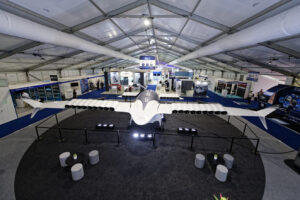
Lilium, the developer of the revolutionary all-electric vertical take-off and landing (eVTOL) jet, made waves at the Farnborough International Airshow this week. The company announced several strategic partnerships ahead of the first customer deliveries scheduled for 2026.
Headquartered in Munich, Germany, Lilium was founded in 2015 with the vision of creating a sustainable and accessible high-speed regional transport mode for people and goods. With its eVTOL aircraft, the Lilium Jet, the company is committed to accelerating the decarbonisation of air travel. The innovative jet boasts industry-leading capacity, low noise and high performance, while offering zero-emission operation.
The Lilium Jet uses a unique configuration of multiple ducted propellers, driven by electric motors, to provide lift during take-off and landing, as well as thrust during cruise. The production prototype is powered by 30 electric motors: six on each of the two forward canards and nine on each rear wing, mounted above ten tilting tail flaps. These tail flaps pivot downward to enable vertical takeoff, while forward thrust is generated during the transition to horizontal flight.
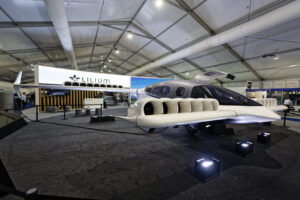
Earlier this month, Lilium took a major step towards commercialisation by signing a binding sales agreement with Saudia Group. The agreement includes a confirmed order for 50 Lilium Jets, with an option for an additional 50. This is the largest commitment to date in the eVTOL sector by an airline planning to operate the aircraft, and the largest in the MENA region. Prior to commercialisation, Saudia Group will provide strategic support for Lilium’s certification process with the General Authority for Civil Aviation (GACA), Saudi Arabia’s aviation regulatory agency.
This agreement with Saudia Group represents a new addition to Lilium’s order book, which now includes 106 firm orders and reservations, 76 options and approximately 600 aircraft under Memorandum of Understanding.
The Lilium Jet MSN 2, whose first manned flight is now scheduled for early 2025, is currently being assembled with its fuselage, landing gear, wing, canard and electrical harnesses.
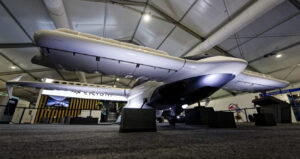
CEO Klaus Roewe: “Our latest programme review highlighted that our plan for 2026 first deliveries is confirmed despite the new timeline for the first flight, with no material impact on customer deliveries. With EASA, we continue to be working on the highest safety level of our product and we are ramping up production of our test aircraft. We also want to announce by year-end the 2026 launch location of the Lilium Jet with one of our customers.”

The Lilium Jet combines the convenience of vertical takeoff with the speed of a jet for regional, intercity missions. It features 30 battery-electric motors in the main wings and canard flaps, the only moving exterior parts. These flaps tilt down during hover and align during cruise, improving aerodynamics and enabling seamless operation between the airframe and powerplant. The Lilium Jet delivers the highest lift-to-drag (L/D) ratio in the eVTOL industry, comparable to that of airliners at 35,000 feet, and boasts the lowest wing thickness (t/c) ratio, only half that of the V-22 Osprey. This advanced airfoil combines the convenience of vertical takeoff with the increased speed of an aircraft. As cellular technology improves, the Lilium Jet will deliver the greatest range leaps of any eVTOL.

Optimised for regional intercity missions, the Lilium Jet maximises horizontal flight efficiency, using only 10% of available power during cruise, the longest phase of regional travel. This efficiency, combined with high-density 330 Wh/kg batteries, provides a significant range advantage, allowing the company to create new routes that do not exist today while operating from existing airports and heliports.
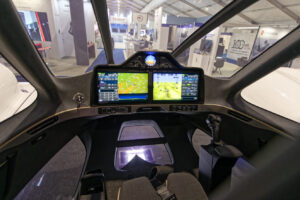
Stephen Vellacott, Chief Technology Officer at Lilium: “Completion of the first engine test is a significant achievement for Lilium, demonstrating once again Lilium’s credentials as a world leader in the development of electric jet propulsion technology. Over the past years, we have invested heavily in the technology and secured extensive IP rights. We now move a step closer to the first manned flight and beyond that to the era of commercial electric flight.”
The jet integrates seamlessly into existing heliports or landing pads. There is no need for extravagant vertiports or sophisticated terminals to accommodate the Lilium Jet, unless customers desire it, ensuring its adoption is simple and cost-effective.
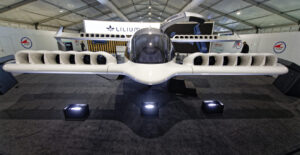
The Lilium Jet uses an industry-standard CCS charger for simple and cost-effective adoption, with the charging port conveniently located to the right of the nose landing gear. It easily integrates into any parking station and a typical charging session lasts approximately 45 minutes. Once fully charged, the jet is designed to handle long-range missions at a cruising speed of 248 km/h (154 mph), achieving a maximum operational range of up to 175 km (109 miles).
The Lilium Jet simplifies operations with a charger-only configuration, requiring only standard ground support equipment and bespoke ground cooling systems. This approach will allow owners to leverage existing infrastructure by simply electrifying their parking bays with universal chargers. This will reduce installation costs and improve operational efficiency.





